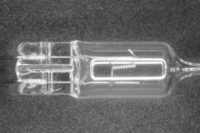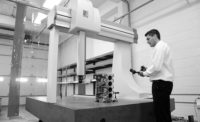
Multicore glass optical fibers provide reliable data transmission. Source: Schott
The quality of machine vision results strongly depends on the quality of lighting, with lighting and optics often credited for 80% of the application. By using different lighting techniques, different features of the object can be made visible.
The purpose of illumination is to enhance the contrast of the object in a way that the desired feature is detectable by the machine vision system. Fiber optic or light-emitting diode (LED) illumination facilitates optimum lighting of an object and, therefore, makes an important contribution to successful machine vision. For optimum results, each feature requires a different illumination technique.
Polymer optical fibers (POF) have been used for data transmission in networks for more than a decade. This choice was based on their high bandwidth, low space requirement, easy handling and insensitivity to electromagnetic fields. However, aside from these advantages, the polymethylmethacrylate (PMMA) polymer optical fiber with step index (SI-POFs) used today also has some limitations.
Bends with a radius of less than 20 millimeters must be avoided, while the operating temperature may not exceed 85 C. This precludes, for example, their use in high temperature environments.
With the multicore glass optical fibers (MC-GOF) now available in the market, both disadvantages can be eliminated without affecting the remaining optical characteristics. But there are still applications where polymer optical fibers make more sense than glass.
Optical Networks
Single-mode glass optical fibers have taken the lead in worldwide telecommunication networks since up to 25,000,000 megabits per second (Mbit/s) or 25 terabits per second (Tbit/s) can be transmitted via a single fiber. However, in many cases, multimode glass optical fibers are preferred for use in local area networks within offices. These fibers feature 50-micron core diameters, five times thicker than single mode fibers, and thus permit use of lower cost plugs and components. Using more modern multimode glass optical fibers (GOFs), at least 10 gigabits per second (Gbit/s) can be transmitted over a distance of 500 meters.However, these glass optical fiber systems are, as a rule, still too expensive and sensitive for many common applications such as cars, homes or industrial control systems. That is why more POF-based systems have been brought into operation in the past few years. Low-cost plugs and LED transmitters reduce total costs and enable robust and reliable connections.
Automation Technology
One millimeter polymer optical fibers have been successfully used in automation technology for the past 15 years. Older fieldbus systems achieved a speed of up to 12 Mbit/s; today, more and more systems with 100 Mbit/s Ethernet are employed. If the maximum POF operating temperature of 85 C is insufficient, then much thinner quartz glass optical fibers also are used. Separation of electrical potentials and insensitivity to electromagnetic fields are the primary reasons for using optical connections.
These optical devices for diagnostic connectors are made out of one-millimeter-thick fibers. Source: Schott
"Plastic" or Glass?
Most of the polymer optical fibers used today are made of PMMA. In fibers with a core diameter of 1 millimeter, the numerical aperture (NA) equals 0.50, which corresponds to a maximum launch angle of ±30 degrees. The core diameter and NA combination result in a minimum bending radius of about 20 millimeters. A glass optical fiber with the same diameter would be much less flexible and could hardly be bent. Splitting the fibers into several individual cores solves the problem. In the MC-GOF described here, approximately 400 single cores of 53 microns core diameter each are assembled in a loose bundle. During cable bending, the individual fibers can move freely so that hardly any tensile stress is generated. Bending radii of a few millimeters can be realized without perceptible additional optical losses.Due to the combination of glass optical fibers and polyamide protective jacket, MC-GOFs can be used at continuous operating temperatures of up to 125 C. The NA is the same as that of POF. That means that these glass optical fiber bundles can be used with the same transmitters and receivers as with POFs.
In certain applications, a combination of glass and polymer optical fibers can provide the best solution. In automobiles, for example, due to the higher temperatures, glass optical fiber must be used in the engine compartment; a simpler plastic optical fiber can be used in the passenger compartment.
An additional advantage of the glass optical fiber vs. POF is its lower attenuation in the near infrared wavelength range. Only LEDs and edge-emitting lasers are available today for the 650-nanometer (red) wavelength used with media-oriented system transport (MOST). Vertical-cavity surface-emitting laser diodes (VCSEL) are available for the 780- and 850-nanometer wavelengths. These diodes are not only fast-up to several gigabits per second (Gbit/s)-but also efficient and function with only a few milliamperes of operating current.
1 Gigabit/s and Thick Fibers?
For a long time, the use of fibers with more than 0.2 millimeter-core diameter at a data rate of 1 Gbit/s was considered to be impossible. This assumption was based on the large capacitance of photodiodes. The speed of an optical receiver is determined to a large extent by the RC time constant. This depends on the entrance resistance of the receiver-the larger it is, the more sensitive the receiver-and the electrical capacitance of the photodiode. By nature, thick fibers require large photodiodes, which also feature a large depletion layer capacitance.A study by a consortium of European companies and testing sites recently tackled the question of how much data can be transmitted by 1-millimeter optical fibers. They determined the influence of the RC time constant can be suppressed, for the most part, by the suitable selection of photodiodes and amplifier circuits used. In the interim, a maximum bit rate of 2,500 Mbit/s has been transmitted without errors over 10 meters POF. That is at least 100 times the current MOST bit rate.
Significantly, more than 1,000 Mbit/s can be achieved with 20 to 30 meter fiber lengths. However, several other influencing factors play a role in practical systems. In addition to losses at plug connections, bends and the influence of aging, above all, the impact of temperature fluctuations must be investigated.
The total system-transmitter, optical fiber and receiver-was set up in a climate-controlled testing laboratory to investigate the performance of the system over the desired temperature range.

Optical glass fibers have a small bending radius and chemical and thermal properties that create advantages in durability. Source: Schott
Connection Technology
The greatest difference between MC-GOF and PMMA POF is the connection technology used. In automotive networks, POFs are sawed off with a smooth surface and then a plastic plug is welded on using a laser. The entire process takes less than two seconds.With MC-GOFs, metal ferrules are used. The fiber bundle and ferrule are pressed together at such a high temperature that the bundle diameter is only 1 millimeter, and the spaces between the individual cores almost disappear. The losses in coupling two MC-GOFs are barely higher than those between two POFs. However, this process takes longer than POF installation, and on-site, manual installation is very difficult.
The operator must decide, based on the advantages of bending radius and, particularly, operating temperature, whether the additional bonding effort vs. POF installation is justified. If only the optical fiber must be installed in the higher temperature area, but not the transmitter and receiver, then identical components can be used for POF and MC-GOF.
Future-Oriented
Large core diameter, multicore glass optical fibers have demonstrated their capability of transmitting, even under critical environmental conditions, high data rates of up to 1,000 Mbit/s, which are expected, for example, for next generation automotive databus systems. Small bend radii, high operating temperatures and combinability with dependable VCSELs in the near infrared wavelength range can offset the disadvantage of a different end surface processing method in many application fields.Depending on the application required, the illumination system should have very high transmission, excellent color temperature, good fiber randomization for even illumination, as well as chemical resistance, high flexibility, and mechanical and temperature stability.
A machine vision application may include both standard and customer-specific components, as well as high-quality light sources and optical elements for putting together a complete illumination system. V&S
Tech Tips
Glossary
Byteflight: optical bus system for safety-critical, automotive data transmits 10 Mbit/sD2B: optical field bus for automotive technology transmits 5.65 Mbit/s
MC-GOF: multicore glass optical fiber
MOST: Media-Oriented System Transport bus system for automotive multimedia data transmits 21.2 Mbit/s
NA: numerical aperture, a measure of light collection capability and resolution of lenses. It also describes the angle range in which launched light is guided through an optical fiber.
PA: polyamide
PMMA: polymethylmethacrylate
POF: polymer optical fiber
SI-POF: polymer optical fiber with step index
VCSEL: vertical-cavity surface-emitting laser; a laser diode that emits light perpendicular to the plane of the semiconductor.

